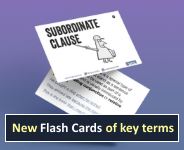Glossary
The Englicious Glossary includes the new National Curriculum glossary terms, which are shown against a white background. However, there's much more to be found here:
- we have added many entries that we feel are important, but cannot be found in the NC Glossary (e.g. connective), and
- in many cases we have added information to the (often very brief) NC entries that need further explanation (e.g. clause and phrase).
Please note that in line with our practice throughout the site, we use capital letters for function terms such as Subject, Direct Object, Indirect Object, Modifier, etc. Although this convention is not followed in the documentation published by the Department for Education we have also done so in the text that forms part of the National Curriculum Glossary.
Tip: Within our units and resources, Glossary items appear highlighted within the text. When you hover over them, or click on them in the Slideshow, a popup is generated.
-ed participle
ellipsis
Ellipsis is the omission of a word or phrase which is expected and predictable.
- Frankie waved to Ivana and [she] watched her drive away.
- She did it because she wanted to [do it].
In addition to grammatical ellipsis, the term ellipsis can also refer to the punctuation mark written with three dots: ...
etymology
A word’s etymology is its history: its origins in earlier forms of English or other languages, and how its form and meaning have changed. Many words in English have come from Greek, Latin or French.
- The word school was borrowed from a Greek word σχολή (skholé) meaning 'leisure'.
- The word verb comes from Latin verbum, meaning 'word'.
- The word mutton comes from French mouton, meaning 'sheep'.

